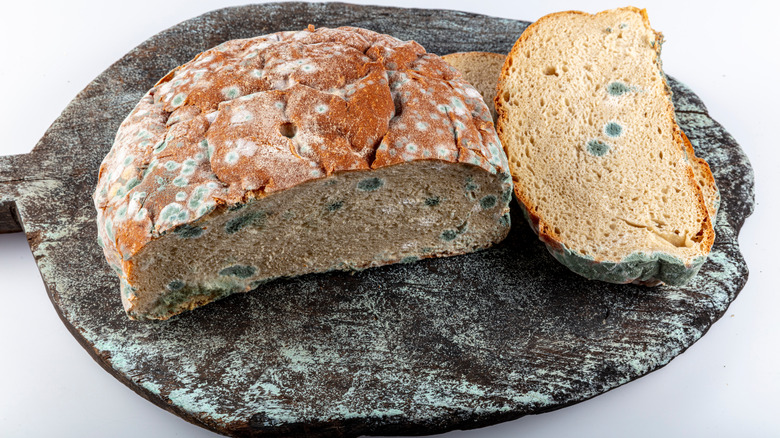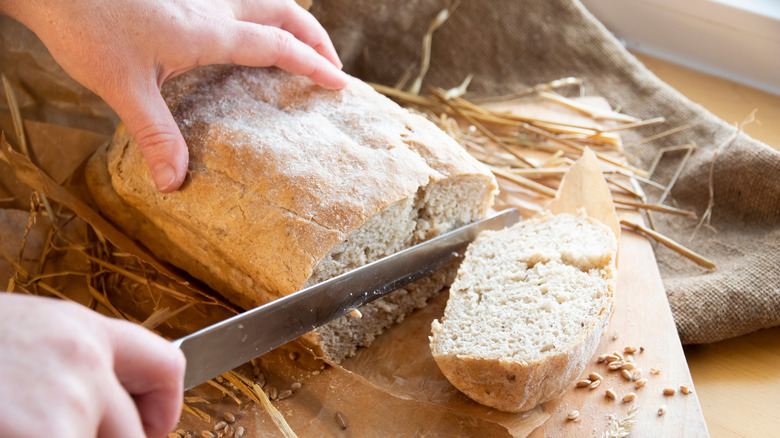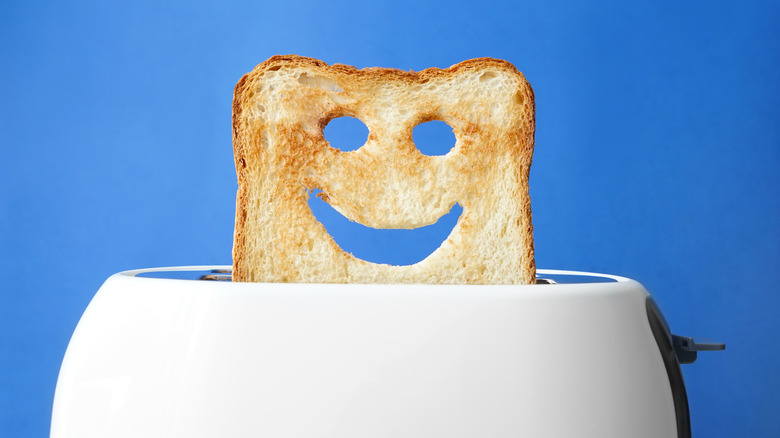The Scientific Reason Stale Bread Is So Tough
We may receive a commission on purchases made from links.
There is nothing quite as delicious as fresh bread. Whether you are enjoying a loaf warm from the oven or fresh from the bakery, there is just something uniquely comforting about this yummy baked good.
Most fresh bread is made with just four basic ingredients: flour, yeast, water, and salt, according to The New York Times Cooking. The flour, which is made from gluten, forms the foundational structure of the bread, while yeast ferments and allows the bread to rise. Water helps to make the bread lighter and more flavorful, as well as aids in the rising process, and salt plays an important part in enhancing the flavor of the bread by preventing the yeast from rising too soon. While other ingredients, such as eggs or sugar, can be added to flavor, sweeten, or thicken the bread, these four core ingredients combine to create a perfectly crusted loaf with a delightfully light, airy center.
However, on the other side of the coin, is there any food more disappointing than a hard, stale loaf of bread? Taking a bite into a slice of bread, only to find it is old, tough, and hard to chew, is certainly an unappetizing experience.
Stale bread hardens due to moisture loss
It turns out, there are scientific reasons why your bread goes from soft and delicious to hard and inedible, and there are some ways to help prevent it. Whenever something goes stale, it is generally the result of exposure to air over time, which causes the food item to lose moisture, thus becoming stale. And while some foods, like chips, soften and lose their crunch when they get old, other food, such as bread, becomes hard. This is all because of the way "the water is finding a balance within its environment," American University Professor Matthew Hartings explained to Insider.
Bread is made up of flour, which has an abundance of starch molecules. During the baking process, water is added and the flour is baked, which weakens the shape of the starch molecules and allows the starch to retain more water, according to BBC Science Focus. This is why bread, when freshly baked, is light and fluffy. However, over time, the starch molecules recrystallize as the water leaves the starch and moves to other parts of the bread. As bread ages, the water molecules tend to migrate toward the crust, thus making the bread dense, hard, and crunchy.
Ways to keep bread fesh
While bread begins to stale almost immediately after it is cooked, how long it stays light and fresh depends in large part on how it is stored. Keeping bread sealed to minimize its exposure to air can help reduce the moisture loss that makes bread harden, keeping it fresher for longer. Wrapping the loaf in plastic wrap or storing the bread in an airtight container or bread box is a great way to help keep moisture locked in and help the bread last, according to MasterClass. It is also a good idea to try to avoid slicing into the loaf whenever possible. The less the interior of the bread is exposed to outside air, the more likely it will be to stay moist and airy.
For long-term storage solutions, bread can even be stored in the freezer for up to two months without becoming stale and hard. However, it is important to remember that while bread can be frozen, it is not recommended to store it in the refrigerator. Storing bread in a cold environment only hastens the evaporation of moisture, causing it to age even more quickly. But if your bread happens to have gone stale, all is not necessarily lost. In some cases, reheating the stale loaf can help loosen the starch molecule's crystalline structure, helping it to soften, per Scientific American. So you might want to try popping a slice into the toaster before tossing that stale loaf of bread.


